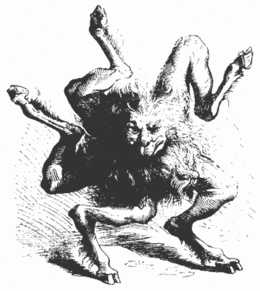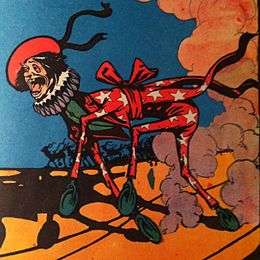Rolling and wheeled creatures in fiction and legend
Legends and speculative fiction reveal a longstanding human fascination with rolling and wheeled creatures. Such creatures appear in mythologies from Europe,[1] Japan,[2] pre-Columbian Mexico,[3] the United States, and Australia.[4]
Rolling creatures

The hoop snake, a creature of legend in the United States and Australia, is said to grasp its tail in its mouth and roll like a wheel towards its prey.[4] Japanese culture includes a similar mythical creature, the Tsuchinoko.[2]
Buer, a demon mentioned in the 16th-century grimoire Pseudomonarchia Daemonum, was described in Collin de Plancy's 1825 edition of Dictionnaire Infernal as having "the shape of a star or wheel".[1] The 1863 edition of this book featured an illustration by Louis Le Breton, depicting a creature with five legs radially arranged.[5]
The 1944 science fiction short story "Arena", by Fredric Brown, features a telepathic alien called an Outsider, which is roughly spherical and moves by rolling.[6] The story was the basis for a 1967 Star Trek episode of the same name, and possibly also a 1964 episode of The Outer Limits entitled "Fun and Games", though neither television treatment included a spherical creature.[7]
The Dutch graphic artist M. C. Escher invented a creature that was capable of rolling itself forward, which he named Pedalternorotandomovens centroculatus articulosus. He illustrated this creature in his 1951 lithograph Wentelteefje (also known by the English title Curl-up).[8][9]
A 1956 Scrooge McDuck comic, Land Beneath the Ground!, by Carl Barks, introduced Terries and Fermies (a play on the phrase terra firma), creatures who move from place to place by rolling. The Terries and Fermies have made a sport of their rolling abilities, causing earthquakes in the process.[10][11]
Tuf Voyaging, a 1986 science fiction novel by George R. R. Martin, features an alien called a Rolleram, described as a "berserk living cannonball of enormous size", which kills its prey by rolling over it and crushing it, before digesting it externally. Adults of the species weigh approximately six metric tons and can roll faster than 50 kilometres per hour (31 miles per hour).[12]
In the Sonic the Hedgehog video game series, which first appeared in 1991, the eponymous Sonic and his sidekick Tails move by rolling.[13][14]
The 1995 short story "Microbe", by Kenyon College biologist and feminist science fiction writer Joan Slonczewski, describes an exploratory expedition to an alien world whose plant and animal life consists entirely of doughnut-shaped organisms.[15][16]
Wheeled creatures
Toy animals with wheels dating from the Pre-Columbian era were uncovered by archaeologists in Veracruz, Mexico in the 1940s. The indigenous peoples of this region did not use wheels for transportation prior to the arrival of Europeans.[3]

| Wikisource has original text related to this article: |
L. Frank Baum's 1907 children's novel Ozma of Oz features humanoid creatures with wheels instead of hands and feet, called Wheelers.[17]
The 1968 novel The Goblin Reservation by Clifford D. Simak features an intelligent alien race that uses biological wheels.[18]
Chorlton and the Wheelies, a British stop-motion-animated television series that aired from 1976 to 1979, was set in "Wheelie World", which was inhabited by three-wheeled creatures called "wheelies".[19]
Piers Anthony's 1977 book Cluster and its sequels feature aliens called Polarians, which locomote by gripping and balancing atop a large ball. The ball is a living, though temporarily separable, portion of the Polarian's body.[20]
David Brin's Uplift Universe includes a wheeled species called the g'Kek, which are described in some detail in the 1995 novel Brightness Reef.[21] In 1996's Infinity's Shore, a g'Kek is described as looking like "a squid in a wheelchair." The g'Kek suffer from arthritic axles in their old age, particularly when living in a high gravity environment.[21][22]
A 1997 novel in the Animorphs series, The Andalite Chronicles, includes an alien called a Mortron, composed of two separate entities: a yellow and black bottom half with four wheels, and a red, elongated head with razor-sharp teeth and concealed wings.[23]
The 2000 novel The Amber Spyglass, by English author Philip Pullman, features an alien race known as the Mulefa, which have diamond-shaped bodies with one leg at the front and back and one on each side. The Mulefa use large, disk-shaped seed pods as wheels. They mount the pods on bone axles on their front and back legs, while propelling themselves with their side legs. The Mulefa have a symbiotic relationship with the seed pod trees, which depend on the rolling action to crack open the pods and allow the seeds to disperse.[24]
In the 2000 novel Wheelers, by English mathematician Ian Stewart and reproductive biologist Jack Cohen, a Jovian species called "blimps" has developed the ability to biologically produce machines called "wheelers", which use wheels for locomotion.[25][26]
The children's television series Jungle Junction, which premiered in 2009, features hybrid jungle animals with wheels rather than legs;[27] one such animal, Ellyvan, is a hybrid of an elephant and a van.[28] These animals traverse their habitat on elevated highways.[29]
See also
References
- 1 2 de Plancy, Jacques-Albin-Simon Collin (1825). Dictionnaire infernal (in French). P. Mongie aîné. p. 478. Retrieved 12 September 2016.
- 1 2 Pruett, Chris (November 2010). "The Anthropology of Fear: Learning About Japan Through Horror Games" (PDF). Interface on the Internet. Pacific University, Oregon: Berglund Center for Internet Studies. 10 (9). Retrieved April 16, 2011.
- 1 2 Gambino, Megan (June 17, 2009). "A Salute to the Wheel". Smithsonian. Archived from the original on June 26, 2017.
- 1 2 Full, Robert; Earis, Kathleen; Wong, Mary; Caldwell, Roy (October 7, 1993). "Locomotion like a wheel?". Nature. Nature Publishing Group. 365 (6446): 495. Bibcode:1993Natur.365..495F. doi:10.1038/365495a0.
- ↑ de Plancy, Jacques-Albin-Simon Collin (1863). Henri Plon, ed. Dictionnaire infernal (in French). p. 123. ISBN 978-2051012775. Retrieved 12 September 2016.
- ↑ Brown, Fredric (1944). Arena. Astounding Stories. ISBN 978-9635234974. Archived from the original on April 14, 2009.
- ↑ Arena title listing at the Internet Speculative Fiction Database
- ↑ Scholtz, Gerhard (2008). "Scarab beetles at the interface of wheel invention in nature and culture?". Contributions to Zoology. National Museum of Natural History Naturalis. 77 (3). ISSN 1875-9866. Archived from the original on October 21, 2016.
- ↑ Escher, Maurits Cornelis (2001). M.C. Escher, the graphic work. Germany: Taschen. pp. 14, 65. ISBN 978-3-8228-5864-6.
- ↑ "Uncle Scrooge: Land Beneath the Ground!". Inducks Database. COA. Retrieved July 15, 2012.
- ↑ "Terries and Fermies". Inducks Database. COA. Retrieved July 15, 2012.
- ↑ Martin, George R.R. (1986). Tuf Voyaging. Baen Books. ISBN 978-0-671-55985-4. Archived from the original on June 3, 2016 – via Le Cercle Fantastique.
- ↑ Sonic Team (June 23, 1991). Sonic the Hedgehog. Sega.
- ↑ Thomas, Lucas M. (January 26, 2007). "Sonic the Hedgehog VC Review". IGN. IGN Entertainment. Archived from the original on January 13, 2016.
- ↑ Switzer, David M. (March 11, 2014). "Microbe". The Science Fiction of Joan Slonczewski. Archived from the original on December 28, 2016.
- ↑ Slonczewski, Joan (1998). Microbe. The Children Star. Tor Science Fiction. ISBN 978-0-312-86716-4. Archived from the original on April 17, 2016.
- ↑ Baum, Lyman Frank (1907). Ozma of Oz. Oz. 3. John Rea Neill (illustrator). Chicago: The Reilly & Britton Co. pp. 44–45. ISBN 978-1-173-24727-0 – via Google Books.
- ↑ Simak, Clifford D. (1968). The Goblin Reservation. New York: G. P. Putnam's Sons. pp. 5, 42. ISBN 978-0-88184-897-7.
- ↑ "Chorlton and the Wheelies (1976 – 1979)". Toonhound.com. Archived from the original on August 5, 2016.
- ↑ Anthony, Piers (October 1977). Cluster. Avon Books. pp. 18–20,143. ISBN 978-1-61756-013-2 – via Google Books.
- 1 2 Brin, David (1995). Brightness Reef. Uplift trilogy. 1. Random House. ISBN 978-0-553-57330-5 – via Google Books.
- ↑ Brin, David (1996). Infinity's Shore. Uplift trilogy. 2. Easton Press. ISBN 978-1-85723-565-4 – via Google Books.
- ↑ Applegate, K. A. (1997). The Andalite Chronicles. Animorphs. Scholastic Press. ISBN 978-0-590-10971-0.
- ↑ Pullman, Philip (2000). The Amber Spyglass. His Dark Materials. 3. Alfred A. Knopf. ISBN 978-0-375-84673-1 – via Google Books.
- ↑ Stewart, Ian; Cohen, Jack (2000). Wheelers. Warner Books. ISBN 978-0-446-52560-2 – via Google Books.
- ↑ "Wheelers". Kirkus Reviews. September 15, 2000. Archived from the original on March 18, 2017.
- ↑ "Disney success for Cornish company". BBC. July 1, 2011. Archived from the original on March 4, 2017.
- ↑ Jungle Junction (2009– ) on IMDb
- ↑ "The Treasure of Jungle Junction". Jungle Junction. Series 1. Episode 4a. October 3, 2009. Disney Channel. Retrieved December 4, 2014.